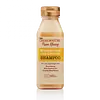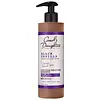What's inside
What's inside
 Key Ingredients
Key Ingredients

No key ingredients
 Benefits
Benefits

 Concerns
Concerns

 Ingredients Side-by-side
Ingredients Side-by-side

Water
Skin ConditioningSodium C14-16 Olefin Sulfonate
CleansingCocamidopropyl Betaine
CleansingCocamide Mea
EmulsifyingParfum
MaskingPolyquaternium-10
Glycol Distearate
EmollientGlycol Stearate
EmollientPolysorbate 20
EmulsifyingPanthenol
Skin ConditioningGlycerin
HumectantDimethicone
EmollientHoney
HumectantCocos Nucifera Oil
MaskingButyrospermum Parkii Butter
Skin ConditioningTriethanolamine
BufferingLauryl Alcohol Diphosphonic Acid
Emulsion StabilisingPentylene Glycol
Skin ConditioningLauric Acid
CleansingMica
Cosmetic ColorantBenzophenone-4
UV AbsorberTetrasodium EDTA
Citric Acid
BufferingPhenoxyethanol
PreservativeSodium Benzoate
MaskingMethylparaben
PreservativeEthylparaben
PreservativeCI 15985
Cosmetic ColorantCI 77891
Cosmetic ColorantCI 14700
Cosmetic ColorantCI 42090
Cosmetic ColorantWater, Sodium C14-16 Olefin Sulfonate, Cocamidopropyl Betaine, Cocamide Mea, Parfum, Polyquaternium-10, Glycol Distearate, Glycol Stearate, Polysorbate 20, Panthenol, Glycerin, Dimethicone, Honey, Cocos Nucifera Oil, Butyrospermum Parkii Butter, Triethanolamine, Lauryl Alcohol Diphosphonic Acid, Pentylene Glycol, Lauric Acid, Mica, Benzophenone-4, Tetrasodium EDTA, Citric Acid, Phenoxyethanol, Sodium Benzoate, Methylparaben, Ethylparaben, CI 15985, CI 77891, CI 14700, CI 42090
Water
Skin ConditioningDisodium Laureth Sulfosuccinate
CleansingCocamidopropyl Betaine
CleansingSodium Lauryl Sulfoacetate
CleansingParfum
MaskingSodium Chloride
MaskingPolyquaternium-10
Polysorbate 20
EmulsifyingPhenoxyethanol
PreservativeHexylene Glycol
EmulsifyingCaprylyl Glycol
EmollientGlyceryl Caprylate
EmollientPEG-150 Distearate
EmulsifyingPolyquaternium-7
Benzyl Salicylate
PerfumingCoumarin
PerfumingBenzoic Acid
MaskingPotassium Sorbate
PreservativePEG-150 Stearate
Potassium Hydroxide
BufferingBenzyl Alcohol
PerfumingCaramel
Cosmetic ColorantGlycerin
HumectantPEG-150
HumectantStearic Acid
CleansingSodium Benzoate
MaskingAloe Barbadensis Leaf Juice
Skin ConditioningCitric Acid
BufferingLimonene
PerfumingBenzyl Benzoate
AntimicrobialRosa Canina Flower Extract
AstringentLavandula Angustifolia Flower Extract
CleansingUrtica Dioica Leaf Extract
Skin ConditioningRosmarinus Officinalis Leaf Extract
AntimicrobialCalendula Officinalis Flower Extract
MaskingMelilotus Officinalis Extract
AstringentSalvia Officinalis Extract
AntimicrobialVanilla Planifolia Fruit Extract
Skin ConditioningPEG-200 Hydrogenated Glyceryl Palmate
CleansingPEG-7 Glyceryl Cocoate
EmulsifyingWater, Disodium Laureth Sulfosuccinate, Cocamidopropyl Betaine, Sodium Lauryl Sulfoacetate, Parfum, Sodium Chloride, Polyquaternium-10, Polysorbate 20, Phenoxyethanol, Hexylene Glycol, Caprylyl Glycol, Glyceryl Caprylate, PEG-150 Distearate, Polyquaternium-7, Benzyl Salicylate, Coumarin, Benzoic Acid, Potassium Sorbate, PEG-150 Stearate, Potassium Hydroxide, Benzyl Alcohol, Caramel, Glycerin, PEG-150, Stearic Acid, Sodium Benzoate, Aloe Barbadensis Leaf Juice, Citric Acid, Limonene, Benzyl Benzoate, Rosa Canina Flower Extract, Lavandula Angustifolia Flower Extract, Urtica Dioica Leaf Extract, Rosmarinus Officinalis Leaf Extract, Calendula Officinalis Flower Extract, Melilotus Officinalis Extract, Salvia Officinalis Extract, Vanilla Planifolia Fruit Extract, PEG-200 Hydrogenated Glyceryl Palmate, PEG-7 Glyceryl Cocoate
Ingredients Explained
These ingredients are found in both products.
Ingredients higher up in an ingredient list are typically present in a larger amount.
Citric Acid is an alpha hydroxy acid (AHA) naturally found in citrus fruits like oranges, lemons, and limes.
Like other AHAs, citric acid can exfoliate skin by breaking down the bonds that hold dead skin cells together. This helps reveal smoother and brighter skin underneath.
However, this exfoliating effect only happens at high concentrations (20%) which can be hard to find in cosmetic products.
Due to this, citric acid is usually included in small amounts as a pH adjuster. This helps keep products slightly more acidic and compatible with skin's natural pH.
In skincare formulas, citric acid can:
While it can provide some skin benefits, research shows lactic acid and glycolic acid are generally more effective and less irritating exfoliants.
Most citric acid used in skincare today is made by fermenting sugars (usually from molasses). This synthetic version is identical to the natural citrus form but easier to stabilize and use in formulations.
Read more about some other popular AHA's here:
Learn more about Citric AcidCocamidopropyl Betaine is a fatty acid created by mixing similar compounds in coconut oil and dimethylaminopropylamine, a compound with two amino groups.
This ingredient is a surfactant and cleanser. It helps gather the dirt, pollutants, and other impurities in your skin to be washed away. It also helps thicken a product and make the texture more creamy.
Being created from coconut oil means Cocamidopropyl Betaine is hydrating for the skin.
While Cocamidopropyl Betaine was believed to be an allergen, a study from 2012 disproved this. It found two compounds in unpure Cocamidopropyl Betaine to be the irritants: aminoamide and 3-dimethylaminopropylamine. High-grade and pure Cocamidopropyl Betaine did not induce allergic reactions during this study.
Learn more about Cocamidopropyl BetaineGlycerin is already naturally found in your skin. It helps moisturize and protect your skin.
A study from 2016 found glycerin to be more effective as a humectant than AHAs and hyaluronic acid.
As a humectant, it helps the skin stay hydrated by pulling moisture to your skin. The low molecular weight of glycerin allows it to pull moisture into the deeper layers of your skin.
Hydrated skin improves your skin barrier; Your skin barrier helps protect against irritants and bacteria.
Glycerin has also been found to have antimicrobial and antiviral properties. Due to these properties, glycerin is often used in wound and burn treatments.
In cosmetics, glycerin is usually derived from plants such as soybean or palm. However, it can also be sourced from animals, such as tallow or animal fat.
This ingredient is organic, colorless, odorless, and non-toxic.
Glycerin is the name for this ingredient in American English. British English uses Glycerol/Glycerine.
Learn more about GlycerinParfum is a catch-all term for an ingredient or more that is used to give a scent to products.
Also called "fragrance", this ingredient can be a blend of hundreds of chemicals or plant oils. This means every product with "fragrance" or "parfum" in the ingredients list is a different mixture.
For instance, Habanolide is a proprietary trade name for a specific aroma chemical. When used as a fragrance ingredient in cosmetics, most aroma chemicals fall under the broad labeling category of “FRAGRANCE” or “PARFUM” according to EU and US regulations.
The term 'parfum' or 'fragrance' is not regulated in many countries. In many cases, it is up to the brand to define this term.
For instance, many brands choose to label themselves as "fragrance-free" because they are not using synthetic fragrances. However, their products may still contain ingredients such as essential oils that are considered a fragrance by INCI standards.
One example is Calendula flower extract. Calendula is an essential oil that still imparts a scent or 'fragrance'.
Depending on the blend, the ingredients in the mixture can cause allergies and sensitivities on the skin. Some ingredients that are known EU allergens include linalool and citronellol.
Parfum can also be used to mask or cover an unpleasant scent.
The bottom line is: not all fragrances/parfum/ingredients are created equally. If you are worried about fragrances, we recommend taking a closer look at an ingredient. And of course, we always recommend speaking with a professional.
Learn more about ParfumPhenoxyethanol is a preservative that has germicide, antimicrobial, and aromatic properties. Studies show that phenoxyethanol can prevent microbial growth. By itself, it has a scent that is similar to that of a rose.
It's often used in formulations along with Caprylyl Glycol to preserve the shelf life of products.
Polyquaternium-10 is an ammonium salt of hydroxyethylcellulose. It is a white and granular powder used as a film-former and anti-static agent.
This ingredient is commonly found in hair conditioning products. According to a manufacturer, its positive charge makes it great for absorbing hair proteins. The manufacturer also states this ingredient helps with curl retention.
For haircare friends: this ingredient is not a silicone.
Learn more about Polyquaternium-10Polysorbate 20 is made by combining ethoxylation of sorbitan, ethylene oxide, and lauric acid. It is a mild cleansing agent, surfactant, and emulsifier.
As a surfactant, it helps collect dirt and oils for washing. Emulsifiers prevent oils and water from separating.
Polysorbate 20 also adds scent to a product. Since it is made using sorbitol, it has a sweet scent. Sorbitol can also be found in fruits such as apples and peaches.
The lauric acid used to create Polysorbate 20 is often derived from coconuts.
Polysorbate 20 may not be fungal acne safe.
Learn more about Polysorbate 20Sodium Benzoate is a preservative. It's used in both cosmetic and food products to inhibit the growth of mold and bacteria. It is typically produced synthetically.
Both the US FDA and EU Health Committee have approved the use of sodium benzoate. In the US, levels of 0.1% (of the total product) are allowed.
Sodium benzoate works as a preservative by inhibiting the growth of bacteria inside of cells. It prevents the cell from fermenting a type of sugar using an enzyme called phosphofructokinase.
It is the salt of benzoic acid. Foods containing sodium benzoate include soda, salad dressings, condiments, fruit juices, wines, and snack foods.
Studies for using ascorbic acid and sodium benzoate in cosmetics are lacking, especially in skincare routines with multiple steps.
We always recommend speaking with a professional, such as a dermatologist, if you have any concerns.
Learn more about Sodium BenzoateWater. It's the most common cosmetic ingredient of all. You'll usually see it at the top of ingredient lists, meaning that it makes up the largest part of the product.
So why is it so popular? Water most often acts as a solvent - this means that it helps dissolve other ingredients into the formulation.
You'll also recognize water as that liquid we all need to stay alive. If you see this, drink a glass of water. Stay hydrated!
Learn more about Water